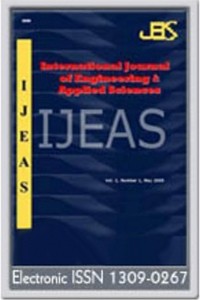Probabilistic Seismic Hazard Analysis of Burdur City
Probabilistic Seismic Hazard Analysis of Burdur City
The aim of this study is to assess seismic hazard for Burdur City (SW Turkey) using a probabilistic approach. A new earthquake catalog for Burdur City and its vicinity, with unified moment magnitude scale, was prepared in the scope of the study. Seismicity of the area was evaluated by the Gutenberg-Richter recurrence relationship. For hazard computation, R-CRISIS (v18) software was used. New Generation Attenuation models were used for analyses. Seismic hazard maps were developed for peak ground acceleration and for bedrock with hazard levels of 2% and 10% probability of exceedance in 50 years. Results of the study show that peak ground acceleration values on bedrock with hazard levels of 2% and 10% probability of exceedance in 50 years change between 0.70-0.75 g and 0.44-0.48 g, respectively.
Keywords:
Burdur, Seismic hazard analysis, PGA R-CRISIS,
___
- Gupta, I.D., The state of the art in seismic hazard analysis. ISET Journal of Earthquake Technology, 39, 311–346, 2002.
- Alpyürür, M. and Lav, M.A., An assessment of probabilistic seismic hazard for the cities in Southwest Turkey using historical and instrumental earthquake catalogs. Natural Hazards, 114, 1-31, 2022.
- Alpyürür, M. and Lav, M.A., Burdur Kent Merkezinin Deterministik Sismik Tehlike Analizi, 9.Türkiye Deprem Mühendisliği Konferansı, İTÜ, İstanbul, 2021.
- Dipova, N. and Cangir, B., Probabilistic seismic hazard assessment for the two layer fault system of Antalya (SW Turkey) area. Journal of Seismology, 21, 1067–1077, 2017.
- Deniz, A, Korkmaz, K.A., Irfanoglu, A., Probabilistic seismic hazard assessment for Izmir, Turkey. Pure and Applied Geophysics, 167, 1475–1484, 2010.
- İnce, G.Ç, Yılmazoğlu M.U., Probabilistic seismic hazard assessment of Muğla, Turkey. Natural Hazards, 1–30, 2021.
- Kırım, S., Budakoğlu, E., Horasan, G., Probabilistic seismic hazard assessment for Isparta province (Turkey) and mapping based on GIS. Arabian Journal of Geosciences, 14, 1–15, 2021.
- Kutanis, M., Ulutaş, H., Işik, E., PSHA of Van province for performance assessment using spectrally matched strong ground motion records. Journal of Earth System Science, 127(7), 1-14, 2018.
- Över, S., Yilmaz, H., Pinar, A., Özden, S., Ünlügenç, U. C., Kamaci, Z., Plio-Quaternary Stress State in the Burdur Basin, SW-Turkey. Tectonophysics, 588, 56–68, 2013.
- Taymaz, T. and Price, S., The 1971 May 12 Burdur earthquake sequence, SW Turkey: a synthesis of seismological and geological observations. Geophysical Journal International, 108(2), 589–603, 1992.
- Asti, R, Faccenna, C., Rossetti, F., et al., The Gediz supradetachment system (SW Turkey): magmatism, tectonics, and sedimentation during crustal extension. Tectonics, 38, 1414–1440, 2019.
- Aktug, B., Nocquet, J.M., Cingöz, A., et al., Deformation of western Turkey from a combination of permanent and campaign GPS data: Limits to block‐like behavior. Journal of Geophysical Research: Solid Earth, 114, 2009.
- Gutenberg, B. and Richter, C.F., Frequency of earthquakes in California. Bulletin of the Seismological Society of America, 34, 185–188, 1944.
- Ordaz, M., and Salgado-Gálvez, M.A., R-CRISIS validation and verification document. Technical Report. Mexico City, Mexico, 2017.
- Cornell, C.A. and Vanmarcke, E.H., The Major Influences on Seismic Risk. Proceedings of the fourth world conference on earthquake engineering, 69–83, 1969.
- Bayrak, Y., and Bayrak, E., An Evaluation of Earthquake Hazard Potential for Different Regions in Western Anatolia Using the Historical and Instrumental Earthquake Data. Pure and Applied Geophysics, 169(10), 1859–1873, 2012.
- Kalafat, D., Güneş, Y., Kara, M., Deniz, P., Kekovalı, K., Kuleli, H. S., Gülen, L., Yılmazer, M., Özel, N., A revised and extended earthquake catalogue for Turkey since 1900 (M≥ 4.0). Boğaziçi University, Kandilli Rasathanesi ve Deprem Araştırma Enstitüsü, Bebek-İstanbul, 553, 2007.
- Akkar, S., Azak, T., Çan, T., Çeken, U., Demircioğlu, M. B., Duman, T., Erdik, M., Ergintav, S., Kadirioğlu, F. T., Kalafat, D., Türkiye sismik tehlike haritasının güncellenmesi projesi.UDAP-Ç-13-06, AFAD, 2014.
- Reasenberg, P., Second‐order moment of central California seismicity, 1969–1982. Journal of Geophysical Research: Solid Earth, 90(B7), 5479–5495, 1985.
- Wiemer, S., A software package to analyze seismicity: ZMAP. Seismological Research Letters, 72(3), 373–382, 2001.
- Aki, K., Maximum likelihood estimate of b in the formula log N= a-bM and its confidence limits. Bull. Earthq. Res. Inst., Tokyo Univ., 43, 237–239, 1965.
- Gregori, S. D., and Christiansen, R., Seismic hazard analysis for central-western Argentina. Geodesy and Geodynamics, 9(1), 25–33, 2018.
- Yunatcı, A.A., GIS Based seismic hazard mapping of Turkey, Ph.D. thesis, Middle East Technical University, Ankara, Turkey, 2010.
- Abrahamson, N.A., Silva, W.J., Kamai, R., Summary of the ASK14 ground motion relation for active crustal regions. Earthquake Spectra, 30(3), 1025–1055, 2014.
- Campbell, K.W. and Bozorgnia, Y., NGA-West2 ground motion model for the average horizontal components of PGA, PGV, and 5% damped linear acceleration response spectra. Earthquake Spectra, 30(3), 1087–1115, 2014.
- Chiou, B.S.J. and Youngs, R.R., Update of the Chiou and Youngs NGA model for the average horizontal component of peak ground motion and response spectra. Earthquake Spectra, 30(3), 1117–1153, 2014.
- Boore, D.M., Stewart, J.P., Seyhan, E., Atkinson, G.M., NGA-West2 equations for predicting PGA, PGV, and 5% damped PSA for shallow crustal earthquakes. Earthquake Spectra, 30(3), 1057–1085, 2014.
- Idriss, I.M., An NGA-West2 Empirical model for estimating the horizontal spectral values generated by shallow crustal earthquakes. Earthquake Spectra, 30(3), 1155–1177, 2014.
- Akkar, S., Sandıkkaya, M.A., Bommer, J.J., Empirical ground-motion models for point- and extended-source crustal earthquake scenarios in Europe and the Middle East. Bulletin of Earthquake Engineering, 12(1), 359–387, 2014.
- Derras, B., Bard, P.Y., Cotton, F., Site-condition proxies, ground motion variability, and data-driven GMPEs: Insights from the NGA-West2 and RESORCE data sets. Earthquake Spectra, 32(4), 2027–2056, 2016.
- Cornell, C.A., Engineering seismic risk analysis. Bulletin of the Seismological Society of America, 58(5), 1583–1606, 1968.
- Başlangıç: 2009
- Yayıncı: Akdeniz Üniversitesi
